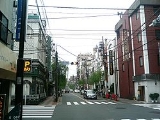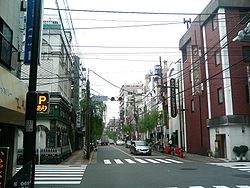
Akasen
Encyclopedia

Japanese language
is a language spoken by over 130 million people in Japan and in Japanese emigrant communities. It is a member of the Japonic language family, which has a number of proposed relationships with other languages, none of which has gained wide acceptance among historical linguists .Japanese is an...
slang
Slang
Slang is the use of informal words and expressions that are not considered standard in the speaker's language or dialect but are considered more acceptable when used socially. Slang is often to be found in areas of the lexicon that refer to things considered taboo...
and a collective term which was used to identify districts in Japan where prostitution
Prostitution
Prostitution is the act or practice of providing sexual services to another person in return for payment. The person who receives payment for sexual services is called a prostitute and the person who receives such services is known by a multitude of terms, including a "john". Prostitution is one of...
and the sex industry flourished until 1958.
Akasen means literally "red-line". The districts were the designated regions for state-regulated prostitution
Prostitution in Japan
Prostitution in Japan has existed throughout the country's history.While the Anti-Prostitution Law of 1956 states that "No person may either do prostitution or become the customer of it," various loopholes, liberal interpretations of the law, and loose enforcement have allowed the sex industry to...
. Hundreds of government-sanctioned brothel
Brothel
Brothels are business establishments where patrons can engage in sexual activities with prostitutes. Brothels are known under a variety of names, including bordello, cathouse, knocking shop, whorehouse, strumpet house, sporting house, house of ill repute, house of prostitution, and bawdy house...
s and other adult entertainment parlors were operating in these districts, with the most popular being Yoshiwara
Yoshiwara
Yoshiwara was a famous Akasen district in Edo, present-day Tōkyō, Japan.In the early 17th century, there was widespread male and female prostitution throughout the cities of Kyoto, Edo, and Osaka. To counter this, an order of Tokugawa Hidetada of the Tokugawa shogunate restricted prostitution to...
in the Akasen region in Tokyo
Tokyo
, ; officially , is one of the 47 prefectures of Japan. Tokyo is the capital of Japan, the center of the Greater Tokyo Area, and the largest metropolitan area of Japan. It is the seat of the Japanese government and the Imperial Palace, and the home of the Japanese Imperial Family...
.
Another term , literally "blue-line", was used for "non-permitted" or "non-legal" districts. In Tokyo, the area directly across the Sumida river from Yoshiwara (Tamanoi, now called Higashi Mukōjima) was a well-established aosen district; it features in some of Kafū Nagai's short stories.
Akasen is often compared directly with the term red-light district
Red-light district
A red-light district is a part of an urban area where there is a concentration of prostitution and sex-oriented businesses, such as sex shops, strip clubs, adult theaters, etc...
in the west. However, this does not explain why the counterpart "non-permitted districts" were called Aosen (blue-line). In practice, the Aosen and Akasen referred to the colors on municipal zoning maps that outlined brothel districts (Akasen) and "normal" entertainment districts (Aosen).
Abolition
In January, 1946, GHQSupreme Commander of the Allied Powers
Supreme Commander of the Allied Powers was the title held by General Douglas MacArthur during the Occupation of Japan following World War II...
issued an order (SCAPIN 642) nationwide to abolish Japan's licensed prostitution system. Commercial brothels continued to operate, but prostitutes were no longer bound by state-guaranteed contracts. All known houses of prostitution were placed on "Off Limits" status by SCAP GHQ which forced many brothels and parlors to change their name to or in order to continue to attract Occupation business. These businesses fronted a non-adult face (coffee shops, cafes, beer halls, etc.), but would offer sexual services to customers creating a new form of prostitution business. With this development, traditional Akasen prostitution businesses began invading Aosen areas making it difficult for SCAP to identify houses of prostitution and continue its "Off Limits" policy.
In 1958, the was enforced, thus officially abolishing the name Akasen and the districts. However, this did not mean the sex related industry disappeared. To remain in operation, businesses such as and are required to file a license application for permission to abide by the in modern days.
See also
- Street of ShameStreet of Shameis a 1956 black-and-white Japanese film directed by Kenji Mizoguchi, his last film.The film is based on the novel Susaki no Onna by Yoshiko Shibaki.-Cast:* Machiko Kyō as Mickey* Ayako Wakao as Yumeko* Aiko Mimasu as Yasumi* Michiyo Kogure as Hanae...
(Akasen chitai) MizoguchiKenji MizoguchiKenji Mizoguchi was a Japanese film director and screenwriter. His film Ugetsu won the Silver Lion at the Venice Film Festival, and appeared in the Sight & Sound Critics' Top Ten Poll in 1962 and 1972. Mizoguchi is renowned for his mastery of the long take and mise-en-scène...
's 1956 film - SusukinoSusukinois a red-light district located in Chūō-ku, Sapporo, Hokkaidō, Japan. It is one of the major red-light districts in Japan along with Kabukichō, Tokyo, and Nakasu, Fukuoka. Currently, the district is congested with many restaurants, bars, hotels, and adult-entertainment establishments...

